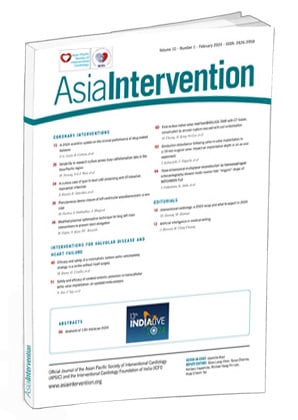Dear friends,
On behalf of AsiaIntervention’s Editorial Board, I wish all of you a belated Happy New Year and welcome you to this 2024 edition of INDIA LIVE.
Since 2010, INDIA LIVE has been a premier annual teaching course for cardiologists, researchers, and medical professionals, serving as a hub to exchange expertise. With over 2,000 participants, it ranks among the largest courses in the Asia-Pacific region. Initially focused on coronary interventions, INDIA LIVE now explores all aspects of structural heart disease. These courses have been highly acclaimed for their scientific content and teaching of the angioplasty technique, and they have received an enthusiastic response from cardiologists and specialists. Rotating between Delhi, Chennai, and Mumbai, the 13th edition of INDIA LIVE is in Delhi this year and features Indian faculty members and 45 international teaching faculty members. The curriculum includes live demonstrations, guest lectures, device workshops, debates, clinical cases, and abstract presentations, making it a monumental annual teaching event.
This special INDIA LIVE issue also heralds a new era for AsiaIntervention, as we embark on the challenges of increasing our publication frequency to 3 issues per year.
The latest issue of AsiaIntervention opens with Mirvat Alasnag and Mognee Alameer’s editorial, “Recap of 2023 trials”, which summarises the major trials of intravascular imaging, including OCTIVUS, OCTOBER, ILUMIEN IV, and a network meta-analysis, showcasing the superiority of intravascular imaging in guiding percutaneous coronary intervention (PCI) for optimal stent outcomes and superior long-term results compared to angiographic guidance.
An insightful editorial from James Howard and Hoi Ching Cheung follows on artificial intelligence and machine learning, addressing their rapid acceptance in medical writing. The editorial delves into the intricacies of “neural networks” and “deep learning”, particularly in the context of large language models like the General Purpose Transformer (GPT).
The coronary interventions section features a review article by Florin-Leontin Lazar, Bernardo Cortese et al discussing the widening indications of drug-coated balloons (DCB) for PCI, including patients with small vessels, diffuse disease, and complex bifurcations, scenarios where dual antiplatelet drugs pose challenges, and hybrid procedures with drug-eluting stents placed proximally and DCB distally. Manish Narang, Nick E.J. West et al shed light on the research landscape of cardiovascular disease in the Asia-Pacific region, emphasising the potential for collaborative efforts to enhance methodology training and encourage industry participation.
The interventions for valvular disease and heart failure section includes a study by Matteo Bruno, Gianni Casella et al involving 187 patients with symptomatic severe valvular aortic stenosis at very high risk for surgical or transcatheter valve replacement. The study proposes balloon aortic valvuloplasty as a bridge to a definitive procedure, showcasing a minimalistic approach with low mortality and morbidity. Nicholas Tan, Jonathan Yap et al address cerebral embolic protection for transcatheter aortic valve implantation procedures with a meta-analysis, indicating a significant reduction in mortality, strokes, and major bleeding complications at 7 and 30 days post-procedure.
Also included are an array of interventional flashlights: Mahendrasingh Parihar, Sachin Mukhedkar and Ajit Bhagwat discuss successful left ventricular pseudoaneurysm closure; Himanshu Gupta, Navjyot Kaur and Pruthvi C. Revaiah look at prevention of stent elongation during long left main artery stenting; and Sushant Kharel, Rikesh Tamrakar et al present an intriguing case of anterior ST-segment elevation myocardial infarction with a dual left anterior descending artery. Michael Chiang, Michael Kang-Yin Lee et al present the first report from Asia on the modified BASILICA TAVR trial, addressing coronary obstruction in patients with a low coronary height. Tomoaki Kobayashi, Teruo Noguchi et al highlight a valve-in-valve procedure that resulted in a complete heart block, offering insights on how to prevent this complication. Finally, Tadatomo Fukushima, Kenji Ando et al showcase a unique three-dimensional multiplanar transoesophageal echocardiographic reconstruction, detailing the imaging of a folded, oversized WATCHMAN FLX device in a left atrial appendage closure procedure.
This issue also includes selected abstracts submitted for presentation at INDIA LIVE. These submissions will undergo a competitive evaluation, with three standout entries earning well-deserved recognition and rewards.
I do hope you find the contents of this issue interesting, thought-provoking, and educative. I wish all the colleagues who are joining INDIA LIVE a very good experience both academically and socially.
Happy reading!
